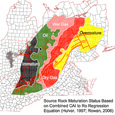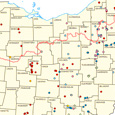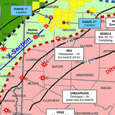Centralia, Pa., is still burning underground
Thursday, March 6, 2003
DENVER – For those who have forgotten, Centralia Pa. is still burning underground and the fire front is still moving.
Centralia became the focus of geologic research that broadened a Penn State psychology undergraduate’s interest to include geology.
Melissa A. Nolter enrolled in Penn State’s Geoscience 20 class at the Schuylkill campus and because she is an honors student, asked if she could do a project to make the class count as an honors class.
Instructor Daniel H. Vice, her instructor, suggested a paper, but left the subject up to her.
Coal country. Nolter learned a lot about the geology of coal country, about mine tunneling and synclines, anticlines and flooding.
Temperature measurements made with a thermometer supplied by Nolter’s father allowed her to measure where the edge of the fire front was and how it advanced through time. The thermometer was one usually used in metallurgical applications at high temperatures.
How it started. The Centralia, Pa., underground coal fire started after the municipality back-burned the town garbage dump in 1962.
Although they thought that all the holes were filled with non-combustible material, one mine hole remained open. The coal seam beneath the dump began to burn and, despite numerous attempts to put out the fire, it still burns.
“At one time, they dug a big trench to try to stop the fire, but they realized that the fire had already passed that point,” said Nolter. “They filled the hole and eventually, the federal government relocated nearly the entire town.”
Fires remain. At one time there were four fire fronts in Centralia, but now only two remain, one to the west, which is still within the now ghost town of Centralia and one to the southwest, which is just past the town.
Nolter took temperature readings all over Centralia including from cracks in the ground that still emit heated gases from the fire to determine the location of the fire front.
Temperature at the fire front, on the surface is about 750 degrees Fahrenheit.
Beds of reddish shale called clinker occurs in Centralia where the fire has heated rocks above 700 degrees Fahrenheit, causing an irreversible mineralogical change in the clay-laden shales.
Front line. Nolter found that the average rate of movement of the fire is 66 feet per year.
The Pennsylvania Department of Environmental Protection measures about 75 feet per year for the advancing fire front.
“The reality is probably in between these measurements,” said the Penn State student. “Some months nothing happens and then suddenly there is an advance; it is not the same every year, or even every month.”
Could burn for century. Centralia’s coal is anthracite, which is notoriously difficult to ignite. Nolter notes that when the fire is in a coal bed, it burns slowly and moves slowly, but when it hits one of the old, abandoned mine tunnels, it advances rapidly to the next bed.
The town is in the heart of the anthracite coal region of Pennsylvania.
Experts suspect that the fire will burn for hundreds of years, before it finally goes out.




